This article needs additional citations for verification .(February 2024) |

The Abondance is a cross breed of cattle which originated in the high valleys of Haute-Savoie, France.
This article needs additional citations for verification .(February 2024) |

The Abondance is a cross breed of cattle which originated in the high valleys of Haute-Savoie, France.
They are medium-sized, with the female weighing in at between 580 and 680 kilograms (kg) and standing 1.30 metres tall. They are golden brown in color with a white head (apart from the eyes), underside of the abdomen, and extremities of its legs. The bull weighs in at between 645 and 820 kilograms (kg) and stands 1.70 metres tall. Their colour is different, with a chestnut red and a bit of white on the head.
Their milk is rich in both fat and protein, with a good balance between the two. The milk is traditionally used to produce Appellation d'Origine Contrôlée (AOC) cheese such as the reblochon, abondance, tome des Bauges and the beaufort. [1] Typical milk production is 5700 kg per lactation.
This breed of cattle is especially appreciated for its ability to withstand extreme variations in temperature, its fertility, its ease of breeding, its milk, its long life and its meat.
It comes from the Chablais in Haute-Savoie, where it was bred by the monks of the abbaye de Saint-Maurice d'Agaune since the 12th century. It was originally known as the chablaisienne.
Currently, there are about 150,000 head of abondance in France. They have also been exported to North America, United Kingdom, New Zealand, Iraq and Africa. In West Africa, they have been cross bred with N'dama.

The Holstein Friesian is an international breed or group of breeds of dairy cattle. It originated in Frisia, stretching from the Dutch province of North Holland to the German state of Schleswig-Holstein. It is the dominant breed in industrial dairy farming worldwide, and is found in more than 160 countries. It is known by many names, among them Holstein, Friesian and Black and White.
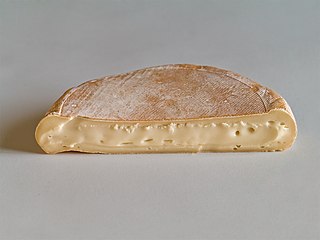
Reblochon is a soft washed-rind and smear-ripened French cheese made in the Alpine region of Haute-Savoie from raw cow's milk. It has its own AOC designation.

The Guernsey is a breed of dairy cattle from the island of Guernsey in the Channel Islands. It is fawn or red and white in colour, and is hardy and docile. Its milk is rich in flavour, high in fat and protein, and has a golden-yellow tinge due to its high β-carotene content. The Guernsey is one of three Channel Island cattle breeds; the other two are the Alderney, which is now extinct, and the Jersey.

Beaufort is a firm, raw cow's milk cheese associated with the gruyère family. An Alpine cheese, it is produced in Beaufortain, Tarentaise valley and Maurienne, which are located in the Savoie region of the French Alps.

Choisy is a commune in the eastern French department of Haute-Savoie.
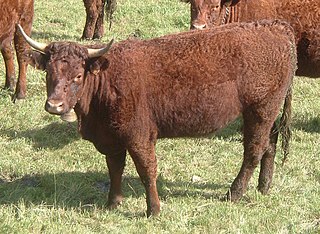
The Salers is a breed of cattle which originated in Cantal in the Massif Central of France.
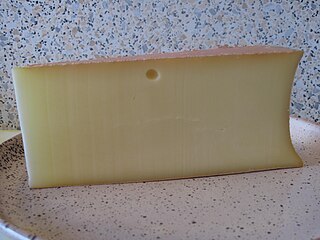
Abondance is a semi-hard, fragrant, raw-milk cheese made in the Haute-Savoie department of France. Its name comes from a small commune also called Abondance. A round of Abondance weighs approximately 10 kg (22 lb), and its aroma is comparable to Beaufort, another French cheese variety. Abondance is made exclusively from milk produced by the Abondance, montbéliarde, and tarine breeds of cattle. By 2022, the herd producing the milk for Abondance cheese will need to be a minimum of 55 percent of the herd. In 1998, 873 tonnes were produced, 34 percent from local farms.

The Gir or Gyr is an Indian breed of zebuine cattle. It originated in the Kathiawar peninsula in the state of Gujarat, and the name of the breed derives from that of the Gir Hills in that region. Other names include Bhodah, Desan, Gujarati, Kathiawari, Sorthi and Surti.

The Aubrac or Laguiole is a French breed of beef cattle. It originates on the Plateau de l'Aubrac in the Massif Central in central southern France, from which it also takes its name. It has a wheat-coloured coat and dark hooves, switch, muzzle and eyes.
The Original Braunvieh is a dual purpose dairy and beef breed from the Switzerland. Braunvieh means "brown cow" and the animals are coloured grey to brown with white ears and muzzle and have horns. These cattle have been maintained as a pure breed, while the modern Swiss Braunvieh have been crossed with Brown Swiss. They have contributed to the American Brown Swiss breed. In the 1980s breeding associations were formed in Germany and Austria to conserve the breed.

Abondance is a commune in the Haute-Savoie department in the Auvergne-Rhône-Alpes region in south-eastern France.

The Aure et Saint-Girons or Casta is an endangered French breed of domestic cattle. The breed name derives from its two principal areas of origin, the Vallée d'Aure in the département of the Hautes-Pyrénées, and the area of Saint-Girons and the Couserans in the Ariège. The name "Casta" derives from its chestnut colour.
Jutland cattle are a rare Danish breed of cattle used in both dairy and beef production. Bred from the indigenous cattle of Jutland the breed could be light grey, dark grey or black pied with upward curving horns. The first herdbook published in 1881 had a small dairy type and a larger beef type. The dairy cows were small, averaging 120 cm high and weighing 350 kg, producing between 800 and 1000 kg of milk per lactation.
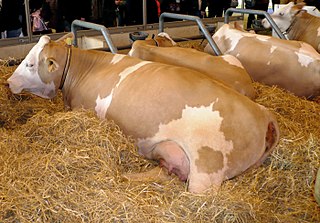
French Simmental is a French cattle breed.

The Blackhead Persian is a fat-tailed breed of domestic sheep from Africa. The sheep is originally from Somalia and a direct descendant of the Somali sheep. The breed is also a type of hair sheep, meaning they do not grow wool and tolerate heat better than wooled breeds and are raised primarily for meat. The Blackhead Persian has a white body and, as their name would suggest, an entirely black head.

Norwegian Red is a breed of dairy cattle developed in Norway starting in 1935.

The Umblachery is an Indian breed of zebuine cattle. It is distributed in the coastal plains of the districts of Nagapattinam, Tiruvarur and Thanjavur in the state of Tamil Nadu in South India. It was bred for draught work, particularly in the rice paddies of the area.

The Valdostana Pezzata Rossa is an Italian breed of cattle from Valle d'Aosta region in north-western Italy. It is red-pied, usually with white legs, stomach and face. It is one of three regional breeds in the area, the others being the Valdostana Castana and the Valdostana Pezzata Nera. Like them, it derives from inter-breeding of various local breeds and types of cattle. The most important of these were Swiss Simmental cattle, which came into the Valle d'Aosta over the Great St. Bernard Pass. The Valdostana Pezzata Rossa is a dual-purpose breed, raised mainly for milk, but also for meat. Management is normally transhumant: the cattle are stabled only in winter, and spend the summer months on the mountain pastures of the Alps.
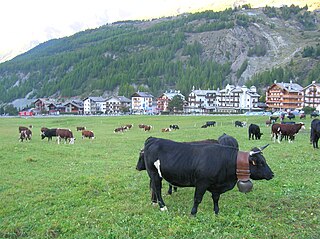
The Valdostana Pezzata Nera is an Italian breed of cattle from Valle d'Aosta region in north-western Italy. It is black-pied, with short horns. It is one of three regional breeds in the area, the others being the Valdostana Castana and the Valdostana Pezzata Rossa. Like them, it derives from inter-breeding of various local breeds and types of cattle. It appears to have been most influenced by the Swiss Fribourgeoise and Hérens breeds, which came into the Valle d'Aosta over the Great St. Bernard Pass. The Valdostana Pezzata Nera is a dual-purpose breed, raised mainly for milk, but also for meat. Management is normally transhumant: the cattle are stabled only in winter, and spend the summer months on the mountain pastures of the Alps.
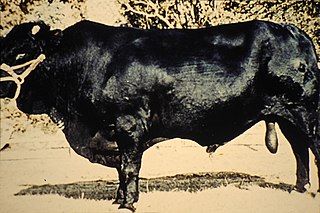
The Drakensberger is a South African breed of cattle. It is a dual-purpose breed, reared both for milk and for meat. Its origins go back to the early nineteenth century, to the time of the Great Trek or earlier, when imported European stock from Holland was cross-bred with black cattle of Sanga type obtained from nomadic pastoralist Khoikhoi peoples. It is one of several successful African composite breeds of Sanga and European stock. In the early days it was selected for adaptation to the sourveld biome of South Africa, and for black colour; it was kept principally along the Drakensberg escarpment, which gave rise to its modern name. It was established as a breed with the formation of the Drakensberger Cattle Breeders' Society in 1947.